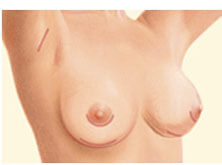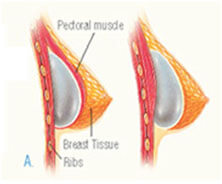
Breast Augmentation
Breast augmentation surgery
- involves using breast implantsor fat, referred to as fat transfer breast augmentation, to increase the size of your breasts or restore breast volume that has been lost after weight reduction or pregnancy.
- Breast augmentation is clinically referred to as augmentation mammaplasty.
- Breast augmentation can:
- Increase fullness and projection of your breasts
- Improve the balance of your figure
- Enhance your self-image and self-confidence
- Breast implants may also be used for breast reconstruction after mastectomy or injury.
- Breast augmentation is a very personal procedure and you should do it for yourself, not for someone else.
- You may be a candidate for breast augmentation surgeryif:
- You are physically healthy
- You have realistic expectations
- Your breasts are fully developed
- You are bothered by the feeling that your breasts are too small
- You are dissatisfied with your breasts losing shape and volume after pregnancy, weight loss, or with aging
- You are unhappy with the upper part of your breast appearing “empty”
- Your breasts are asymmetrical
- One or both breasts failed to develop normally or have an elongated shape
- Many patients find it helpful to review breast augmentation before and after photos during the decision-making process to have surgery.
- During your breast augmentation recovery, you will be taken into a recovery area to be closely monitored following surgery.
- Your breasts will be wrapped in gauze dressings and an elastic bandage or support bra will minimize swelling and support the breasts as they heal.
- You may be permitted to go home after a few hours.
- Before leaving, you will be given specific instructions that may include how to care for your breasts following surgery, medications to apply or take orally to aid healing and reduce the risk of infection, and when to follow-up with your plastic surgeon.
- You may be instructed to wear a support bra around the clock for the first week or two. It will be important to cleanse the incision sites and apply ointment as directed. Be sure to follow all instructions carefully.
- After a post-surgical breast augmentation recovery period of 24 to 48 hours and an additional reduced-activity period of a few days, you will likely experience soreness and swelling for a few weeks.
- Exercise and normal activity can resume at the direction of your plastic surgeon.
- Silicone breast implantsare filled with silicone gel. The gel feels a bit more like natural breast tissue. If the implant leaks, the gel may remain within the implant shell, or may escape into the breast implant pocket. A leaking implant filled with silicone gel will not collapse.
- If you choose silicone implants, you may need to visit your plastic surgeon regularly to make sure the implants are functioning properly. An ultrasound or MRI screening can assess the condition of breast implants.
- Incisions are made in inconspicuous areas to minimize visible scarring. You and your plastic surgeon will discuss which incision options are appropriate for your desired outcome. Incision options include:

- Incisions vary based on the type of breast implant, degree of enlargement desired, your particular anatomy and patient-surgeon preference.
- After the incision is made, a breast implant is inserted into a pocket either:

- Under the pectoral muscle (a submuscular placement), or
- Directly behind the breast tissue, over the pectoral muscle (a submammary/ subglandular placement)
- The method for inserting and positioning breast implants depends on the type of implant, degree of enlargement desired, your body type and your surgeon’s recommendations.
- You will be asked to sign a consent form to ensure you understood everything explained by the doctor regarding the procedure to be done and are aware of the possible and potential complications. The most common complications of this surgery include: accumulation of blood under the skin (hematoma), swelling, infection, poor healing, thrombus formation, and anesthetic complications. After surgery you will wake up to healing dressings on the operated region and whose function is to make local compression. A drain may be used temporarily in the surgical area to prevent any accumulation of fluid or blood and speed up the recovery process.
- The return to normal activities will be gradual and according to the orientation of the surgeon.
Some areas with lack of sensitivity and discreetly hardened in the operated region may occur and gradually improve in the months that follow.
